Effect of Sequential Repetitive Transcranial Magnetic Stimulation With Bilateral Arm Training on the Brain Effective Connectivity in Chronic Stroke
Abstract
This study investigated the effects of combining repetitive transcranial magnetic stimulation (rTMS) with bilateral arm training (BAT) on effective brain connectivity in chronic stroke patients using functional near-infrared spectroscopy. Fifteen post-stroke patients and fifteen healthy individuals were enrolled. Coupling function analysis was performed to evaluate the effective connectivity inflow, outflow, and the dominant information flow (DIF) during standalone BAT and combined rTMS-BAT therapy. Significant task-related alterations were observed in the ipsilesional supplementary motor area and occipital lobe (OL) of stroke patients undergoing rTMS-BAT. During BAT, stroke patients exhibited more pronounced DIF from the OL to motor areas compared to healthy controls. Furthermore, in the rTMS-BAT condition, patients demonstrated enhanced DIF from the ipsilesional OL and contralesional prefrontal cortex to ipsilesional motor areas. These findings suggested a potential synergistic effect on cortical reorganization through the sequential combination of task-related training and TMS in chronic stroke patients, offering insights into rehabilitation strategies.


 求助内容:
求助内容: 应助结果提醒方式:
应助结果提醒方式:


